Economics Assignment: Analysis of Inflation and Its Economic Effects
VerifiedAdded on 2020/05/01
|12
|3006
|80
Essay
AI Summary
This economics assignment provides a comprehensive analysis of inflation, defining it as the rise in the general price level within a country and the resulting decrease in the currency's value. The assignment explores various types of inflation, including demand-pull and cost-push, and examines the role of inflation in redistributing money and its impact on debtors, investors, and international trade. It delves into the effects of inflation on consumer consumption, fiscal policy, and government expenditure, highlighting how inflation influences investment decisions. The assignment also discusses the Phillips curve, which illustrates the relationship between inflation and unemployment, and concludes by emphasizing the multifaceted nature of inflation and its influence on economic stability and growth. The paper analyzes the impact of inflation on the consumer consumption, fiscal policy, and firm investment, and the overall effects on the economy.
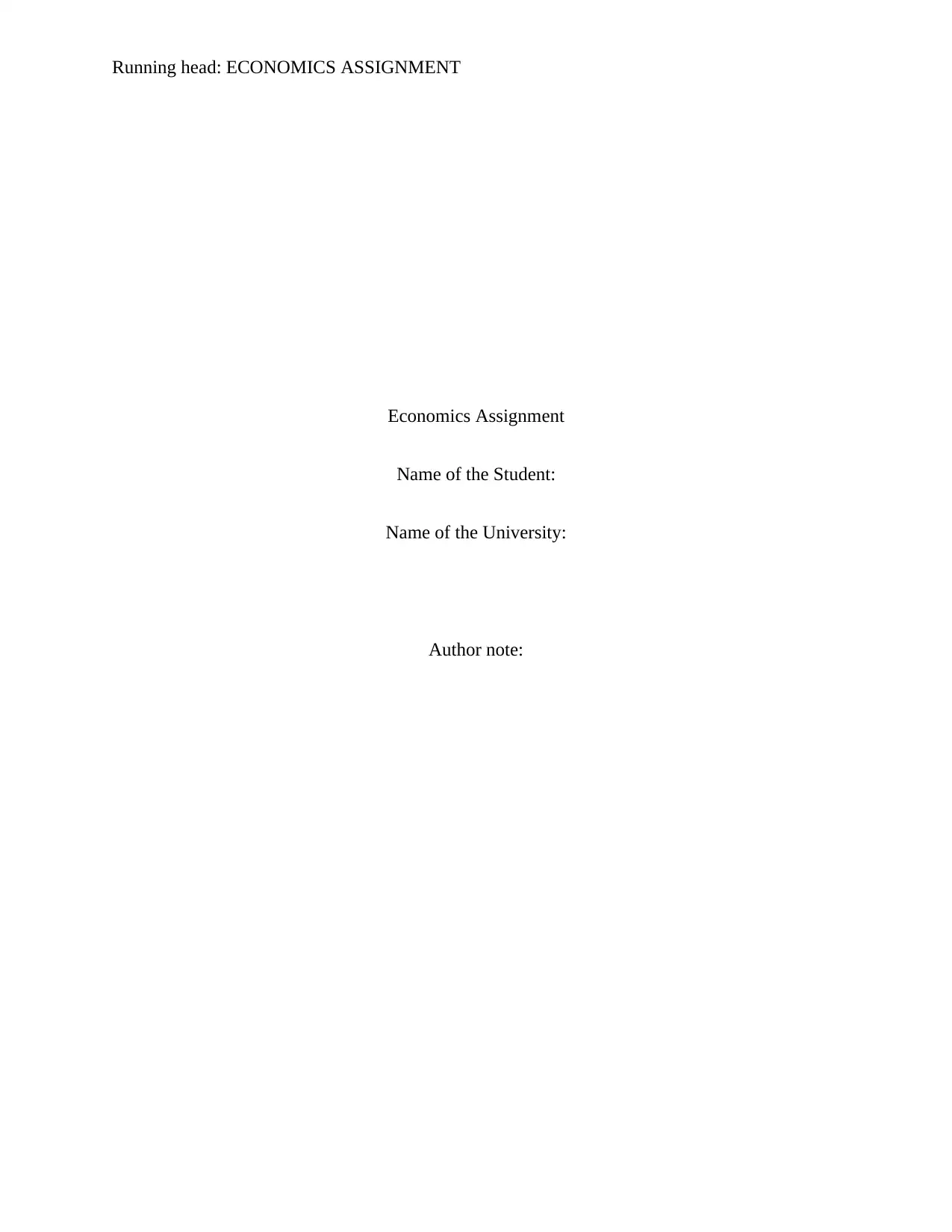
Running head: ECONOMICS ASSIGNMENT
Economics Assignment
Name of the Student:
Name of the University:
Author note:
Economics Assignment
Name of the Student:
Name of the University:
Author note:
Paraphrase This Document
Need a fresh take? Get an instant paraphrase of this document with our AI Paraphraser
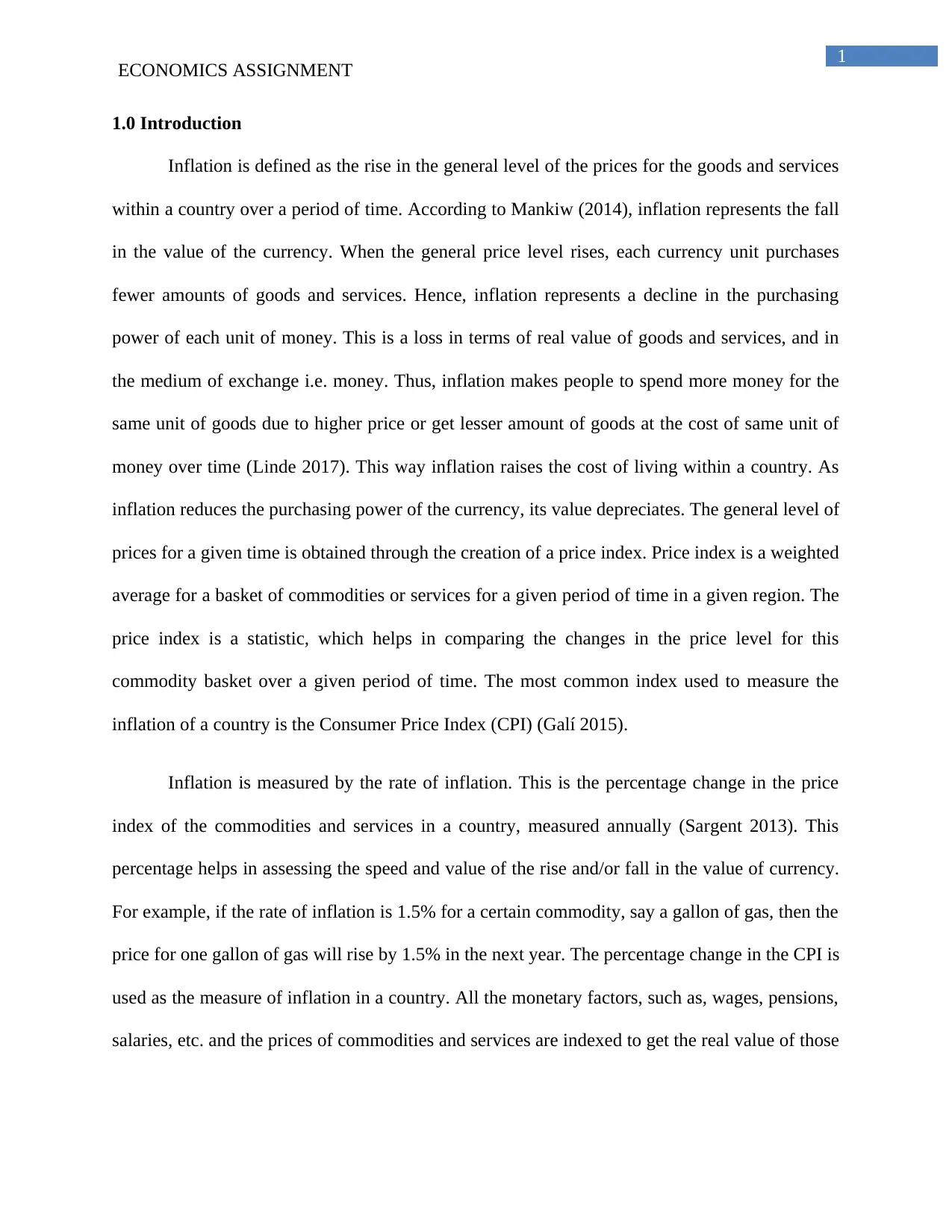
1
ECONOMICS ASSIGNMENT
1.0 Introduction
Inflation is defined as the rise in the general level of the prices for the goods and services
within a country over a period of time. According to Mankiw (2014), inflation represents the fall
in the value of the currency. When the general price level rises, each currency unit purchases
fewer amounts of goods and services. Hence, inflation represents a decline in the purchasing
power of each unit of money. This is a loss in terms of real value of goods and services, and in
the medium of exchange i.e. money. Thus, inflation makes people to spend more money for the
same unit of goods due to higher price or get lesser amount of goods at the cost of same unit of
money over time (Linde 2017). This way inflation raises the cost of living within a country. As
inflation reduces the purchasing power of the currency, its value depreciates. The general level of
prices for a given time is obtained through the creation of a price index. Price index is a weighted
average for a basket of commodities or services for a given period of time in a given region. The
price index is a statistic, which helps in comparing the changes in the price level for this
commodity basket over a given period of time. The most common index used to measure the
inflation of a country is the Consumer Price Index (CPI) (Galí 2015).
Inflation is measured by the rate of inflation. This is the percentage change in the price
index of the commodities and services in a country, measured annually (Sargent 2013). This
percentage helps in assessing the speed and value of the rise and/or fall in the value of currency.
For example, if the rate of inflation is 1.5% for a certain commodity, say a gallon of gas, then the
price for one gallon of gas will rise by 1.5% in the next year. The percentage change in the CPI is
used as the measure of inflation in a country. All the monetary factors, such as, wages, pensions,
salaries, etc. and the prices of commodities and services are indexed to get the real value of those
ECONOMICS ASSIGNMENT
1.0 Introduction
Inflation is defined as the rise in the general level of the prices for the goods and services
within a country over a period of time. According to Mankiw (2014), inflation represents the fall
in the value of the currency. When the general price level rises, each currency unit purchases
fewer amounts of goods and services. Hence, inflation represents a decline in the purchasing
power of each unit of money. This is a loss in terms of real value of goods and services, and in
the medium of exchange i.e. money. Thus, inflation makes people to spend more money for the
same unit of goods due to higher price or get lesser amount of goods at the cost of same unit of
money over time (Linde 2017). This way inflation raises the cost of living within a country. As
inflation reduces the purchasing power of the currency, its value depreciates. The general level of
prices for a given time is obtained through the creation of a price index. Price index is a weighted
average for a basket of commodities or services for a given period of time in a given region. The
price index is a statistic, which helps in comparing the changes in the price level for this
commodity basket over a given period of time. The most common index used to measure the
inflation of a country is the Consumer Price Index (CPI) (Galí 2015).
Inflation is measured by the rate of inflation. This is the percentage change in the price
index of the commodities and services in a country, measured annually (Sargent 2013). This
percentage helps in assessing the speed and value of the rise and/or fall in the value of currency.
For example, if the rate of inflation is 1.5% for a certain commodity, say a gallon of gas, then the
price for one gallon of gas will rise by 1.5% in the next year. The percentage change in the CPI is
used as the measure of inflation in a country. All the monetary factors, such as, wages, pensions,
salaries, etc. and the prices of commodities and services are indexed to get the real value of those
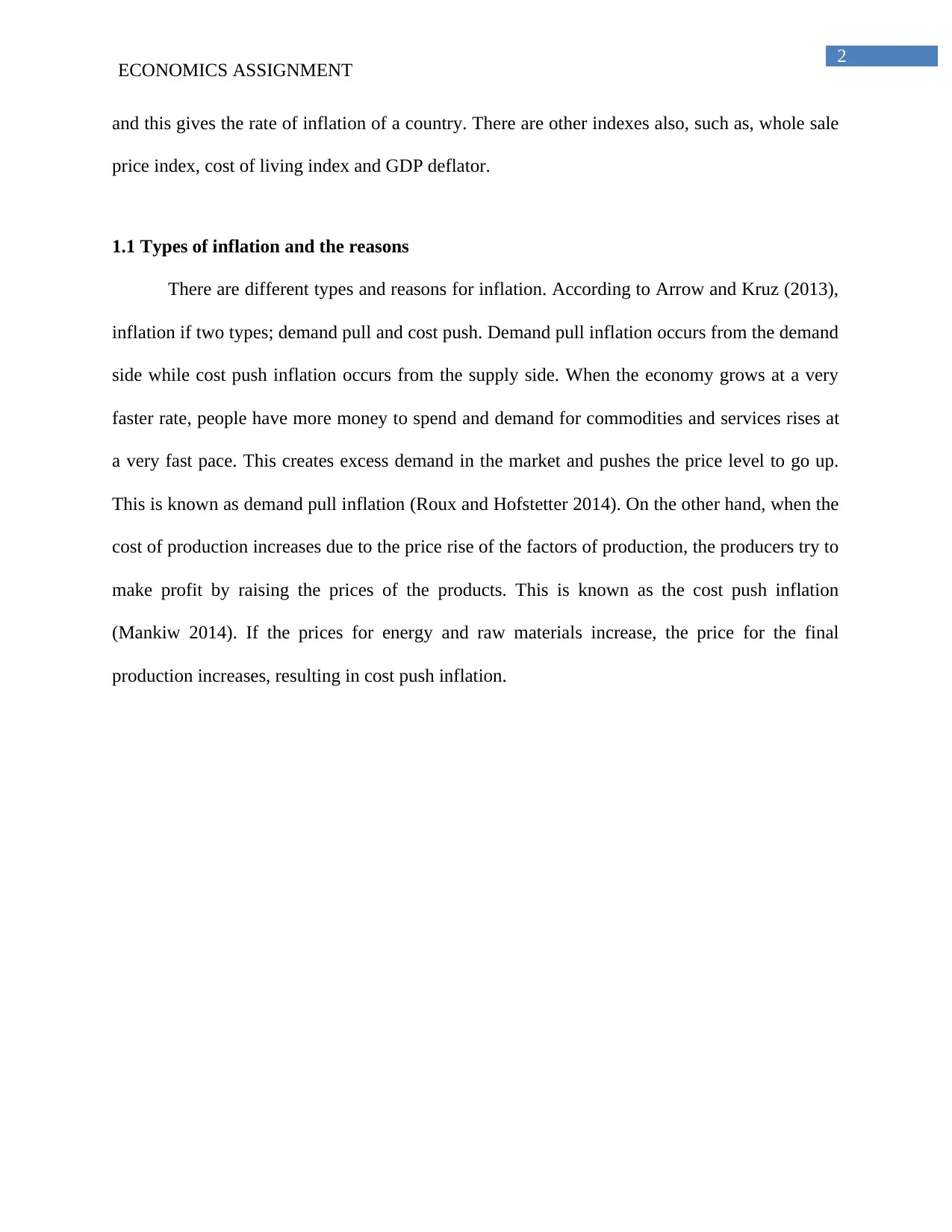
2
ECONOMICS ASSIGNMENT
and this gives the rate of inflation of a country. There are other indexes also, such as, whole sale
price index, cost of living index and GDP deflator.
1.1 Types of inflation and the reasons
There are different types and reasons for inflation. According to Arrow and Kruz (2013),
inflation if two types; demand pull and cost push. Demand pull inflation occurs from the demand
side while cost push inflation occurs from the supply side. When the economy grows at a very
faster rate, people have more money to spend and demand for commodities and services rises at
a very fast pace. This creates excess demand in the market and pushes the price level to go up.
This is known as demand pull inflation (Roux and Hofstetter 2014). On the other hand, when the
cost of production increases due to the price rise of the factors of production, the producers try to
make profit by raising the prices of the products. This is known as the cost push inflation
(Mankiw 2014). If the prices for energy and raw materials increase, the price for the final
production increases, resulting in cost push inflation.
ECONOMICS ASSIGNMENT
and this gives the rate of inflation of a country. There are other indexes also, such as, whole sale
price index, cost of living index and GDP deflator.
1.1 Types of inflation and the reasons
There are different types and reasons for inflation. According to Arrow and Kruz (2013),
inflation if two types; demand pull and cost push. Demand pull inflation occurs from the demand
side while cost push inflation occurs from the supply side. When the economy grows at a very
faster rate, people have more money to spend and demand for commodities and services rises at
a very fast pace. This creates excess demand in the market and pushes the price level to go up.
This is known as demand pull inflation (Roux and Hofstetter 2014). On the other hand, when the
cost of production increases due to the price rise of the factors of production, the producers try to
make profit by raising the prices of the products. This is known as the cost push inflation
(Mankiw 2014). If the prices for energy and raw materials increase, the price for the final
production increases, resulting in cost push inflation.
⊘ This is a preview!⊘
Do you want full access?
Subscribe today to unlock all pages.

Trusted by 1+ million students worldwide
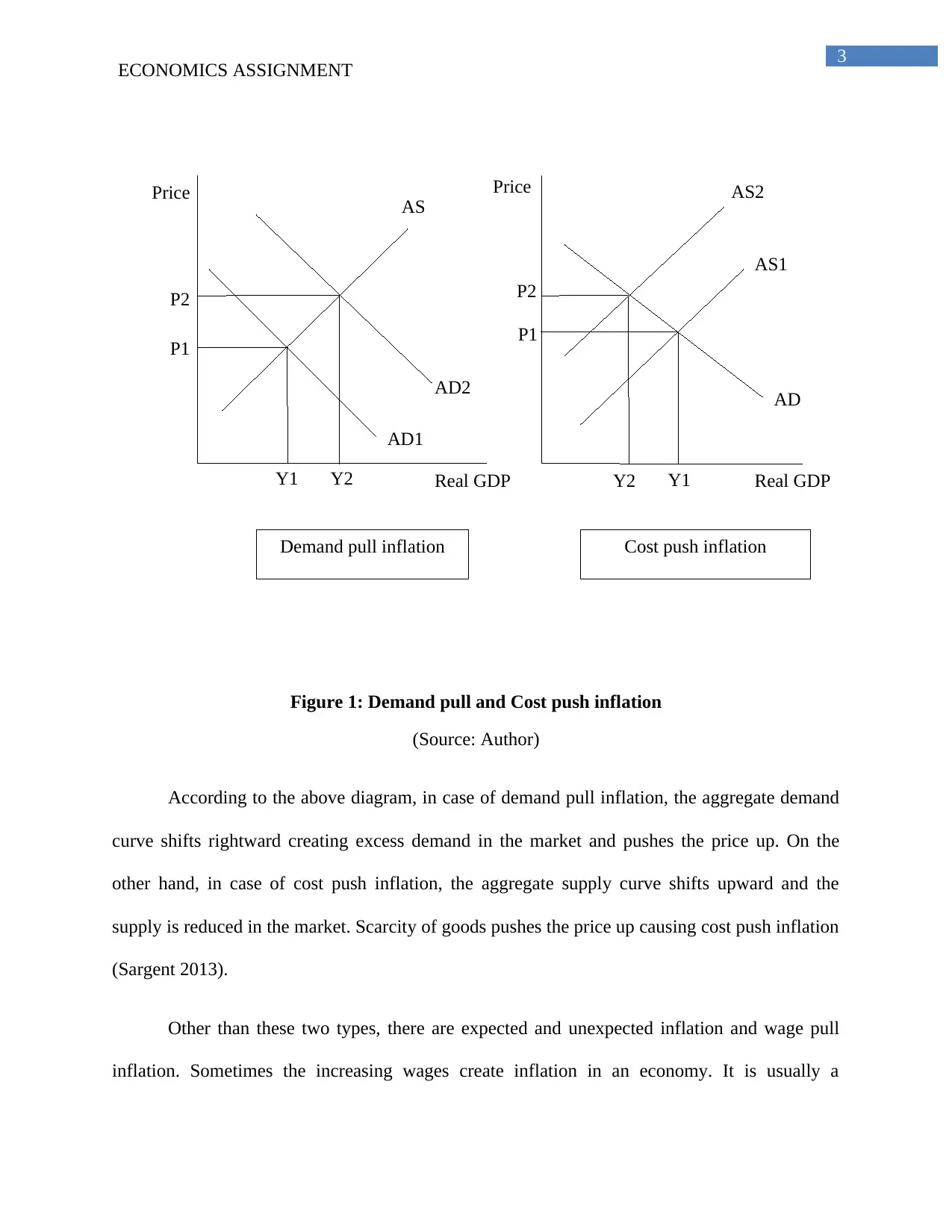
3
ECONOMICS ASSIGNMENT
AS AS2
AS1
AD
AD1
AD2
P1
P2 P2
P1
Price Price
Real GDP Real GDPY1 Y2 Y2 Y1
Demand pull inflation Cost push inflation
Figure 1: Demand pull and Cost push inflation
(Source: Author)
According to the above diagram, in case of demand pull inflation, the aggregate demand
curve shifts rightward creating excess demand in the market and pushes the price up. On the
other hand, in case of cost push inflation, the aggregate supply curve shifts upward and the
supply is reduced in the market. Scarcity of goods pushes the price up causing cost push inflation
(Sargent 2013).
Other than these two types, there are expected and unexpected inflation and wage pull
inflation. Sometimes the increasing wages create inflation in an economy. It is usually a
ECONOMICS ASSIGNMENT
AS AS2
AS1
AD
AD1
AD2
P1
P2 P2
P1
Price Price
Real GDP Real GDPY1 Y2 Y2 Y1
Demand pull inflation Cost push inflation
Figure 1: Demand pull and Cost push inflation
(Source: Author)
According to the above diagram, in case of demand pull inflation, the aggregate demand
curve shifts rightward creating excess demand in the market and pushes the price up. On the
other hand, in case of cost push inflation, the aggregate supply curve shifts upward and the
supply is reduced in the market. Scarcity of goods pushes the price up causing cost push inflation
(Sargent 2013).
Other than these two types, there are expected and unexpected inflation and wage pull
inflation. Sometimes the increasing wages create inflation in an economy. It is usually a
Paraphrase This Document
Need a fresh take? Get an instant paraphrase of this document with our AI Paraphraser
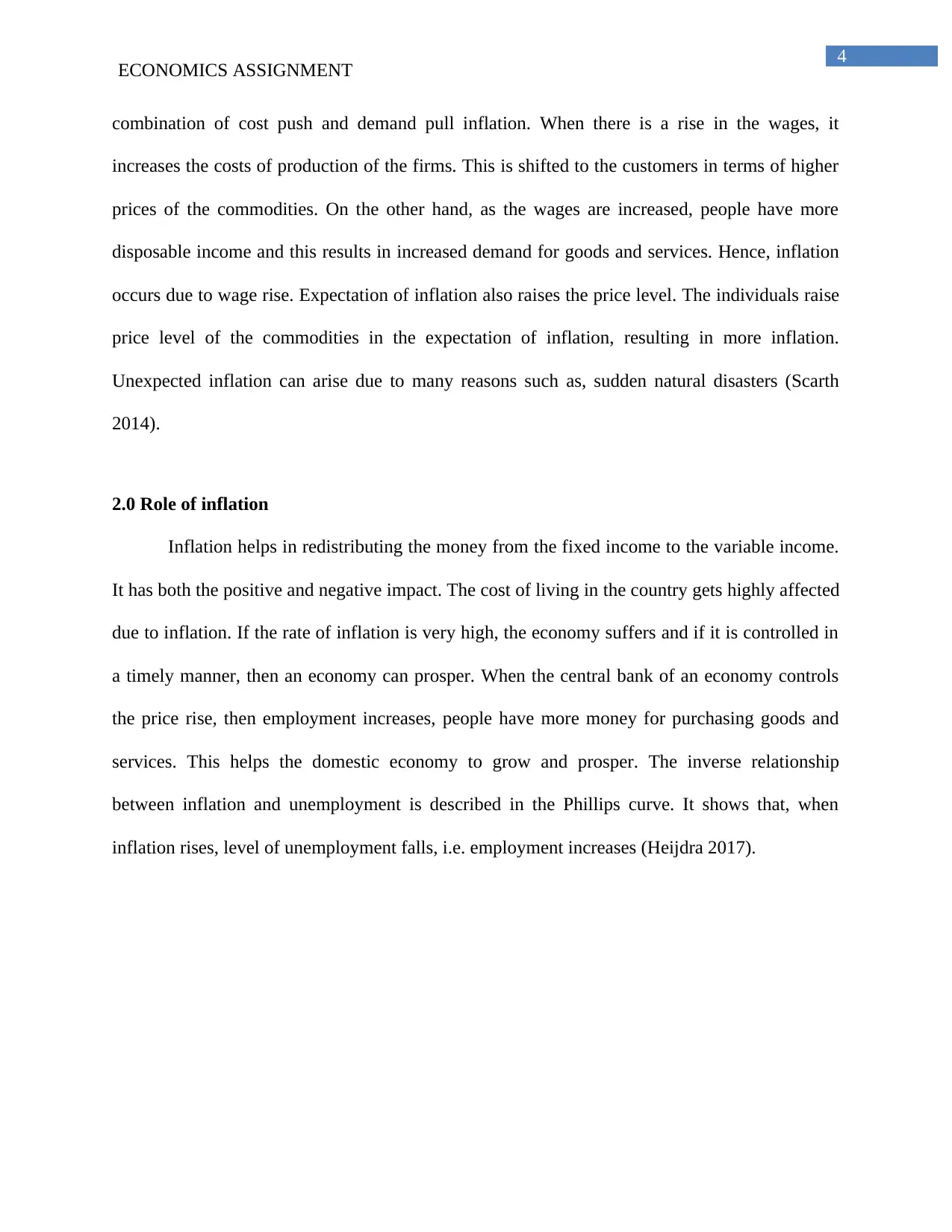
4
ECONOMICS ASSIGNMENT
combination of cost push and demand pull inflation. When there is a rise in the wages, it
increases the costs of production of the firms. This is shifted to the customers in terms of higher
prices of the commodities. On the other hand, as the wages are increased, people have more
disposable income and this results in increased demand for goods and services. Hence, inflation
occurs due to wage rise. Expectation of inflation also raises the price level. The individuals raise
price level of the commodities in the expectation of inflation, resulting in more inflation.
Unexpected inflation can arise due to many reasons such as, sudden natural disasters (Scarth
2014).
2.0 Role of inflation
Inflation helps in redistributing the money from the fixed income to the variable income.
It has both the positive and negative impact. The cost of living in the country gets highly affected
due to inflation. If the rate of inflation is very high, the economy suffers and if it is controlled in
a timely manner, then an economy can prosper. When the central bank of an economy controls
the price rise, then employment increases, people have more money for purchasing goods and
services. This helps the domestic economy to grow and prosper. The inverse relationship
between inflation and unemployment is described in the Phillips curve. It shows that, when
inflation rises, level of unemployment falls, i.e. employment increases (Heijdra 2017).
ECONOMICS ASSIGNMENT
combination of cost push and demand pull inflation. When there is a rise in the wages, it
increases the costs of production of the firms. This is shifted to the customers in terms of higher
prices of the commodities. On the other hand, as the wages are increased, people have more
disposable income and this results in increased demand for goods and services. Hence, inflation
occurs due to wage rise. Expectation of inflation also raises the price level. The individuals raise
price level of the commodities in the expectation of inflation, resulting in more inflation.
Unexpected inflation can arise due to many reasons such as, sudden natural disasters (Scarth
2014).
2.0 Role of inflation
Inflation helps in redistributing the money from the fixed income to the variable income.
It has both the positive and negative impact. The cost of living in the country gets highly affected
due to inflation. If the rate of inflation is very high, the economy suffers and if it is controlled in
a timely manner, then an economy can prosper. When the central bank of an economy controls
the price rise, then employment increases, people have more money for purchasing goods and
services. This helps the domestic economy to grow and prosper. The inverse relationship
between inflation and unemployment is described in the Phillips curve. It shows that, when
inflation rises, level of unemployment falls, i.e. employment increases (Heijdra 2017).
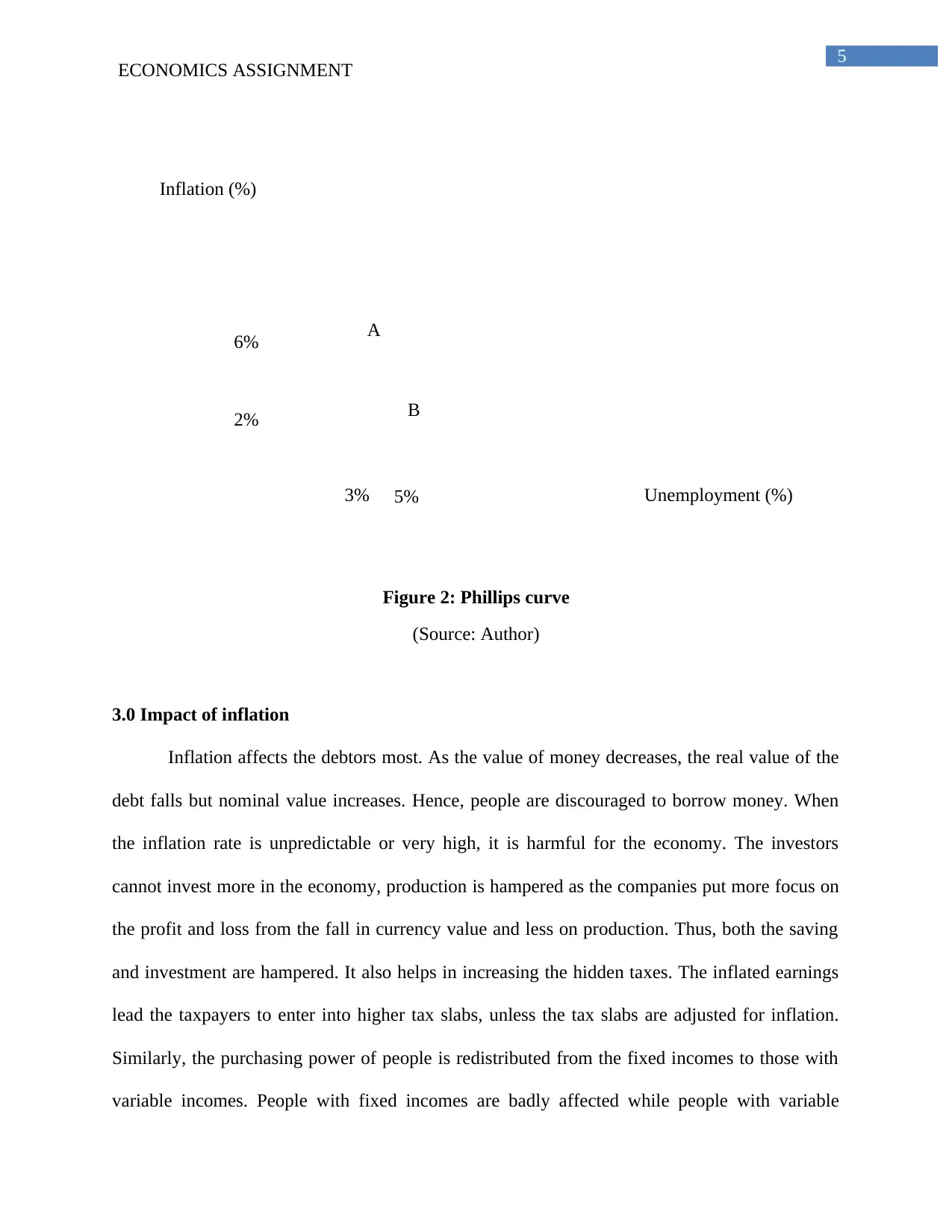
5
ECONOMICS ASSIGNMENT
Inflation (%)
Unemployment (%)
6%
5%3%
2%
A
B
Figure 2: Phillips curve
(Source: Author)
3.0 Impact of inflation
Inflation affects the debtors most. As the value of money decreases, the real value of the
debt falls but nominal value increases. Hence, people are discouraged to borrow money. When
the inflation rate is unpredictable or very high, it is harmful for the economy. The investors
cannot invest more in the economy, production is hampered as the companies put more focus on
the profit and loss from the fall in currency value and less on production. Thus, both the saving
and investment are hampered. It also helps in increasing the hidden taxes. The inflated earnings
lead the taxpayers to enter into higher tax slabs, unless the tax slabs are adjusted for inflation.
Similarly, the purchasing power of people is redistributed from the fixed incomes to those with
variable incomes. People with fixed incomes are badly affected while people with variable
ECONOMICS ASSIGNMENT
Inflation (%)
Unemployment (%)
6%
5%3%
2%
A
B
Figure 2: Phillips curve
(Source: Author)
3.0 Impact of inflation
Inflation affects the debtors most. As the value of money decreases, the real value of the
debt falls but nominal value increases. Hence, people are discouraged to borrow money. When
the inflation rate is unpredictable or very high, it is harmful for the economy. The investors
cannot invest more in the economy, production is hampered as the companies put more focus on
the profit and loss from the fall in currency value and less on production. Thus, both the saving
and investment are hampered. It also helps in increasing the hidden taxes. The inflated earnings
lead the taxpayers to enter into higher tax slabs, unless the tax slabs are adjusted for inflation.
Similarly, the purchasing power of people is redistributed from the fixed incomes to those with
variable incomes. People with fixed incomes are badly affected while people with variable
⊘ This is a preview!⊘
Do you want full access?
Subscribe today to unlock all pages.

Trusted by 1+ million students worldwide
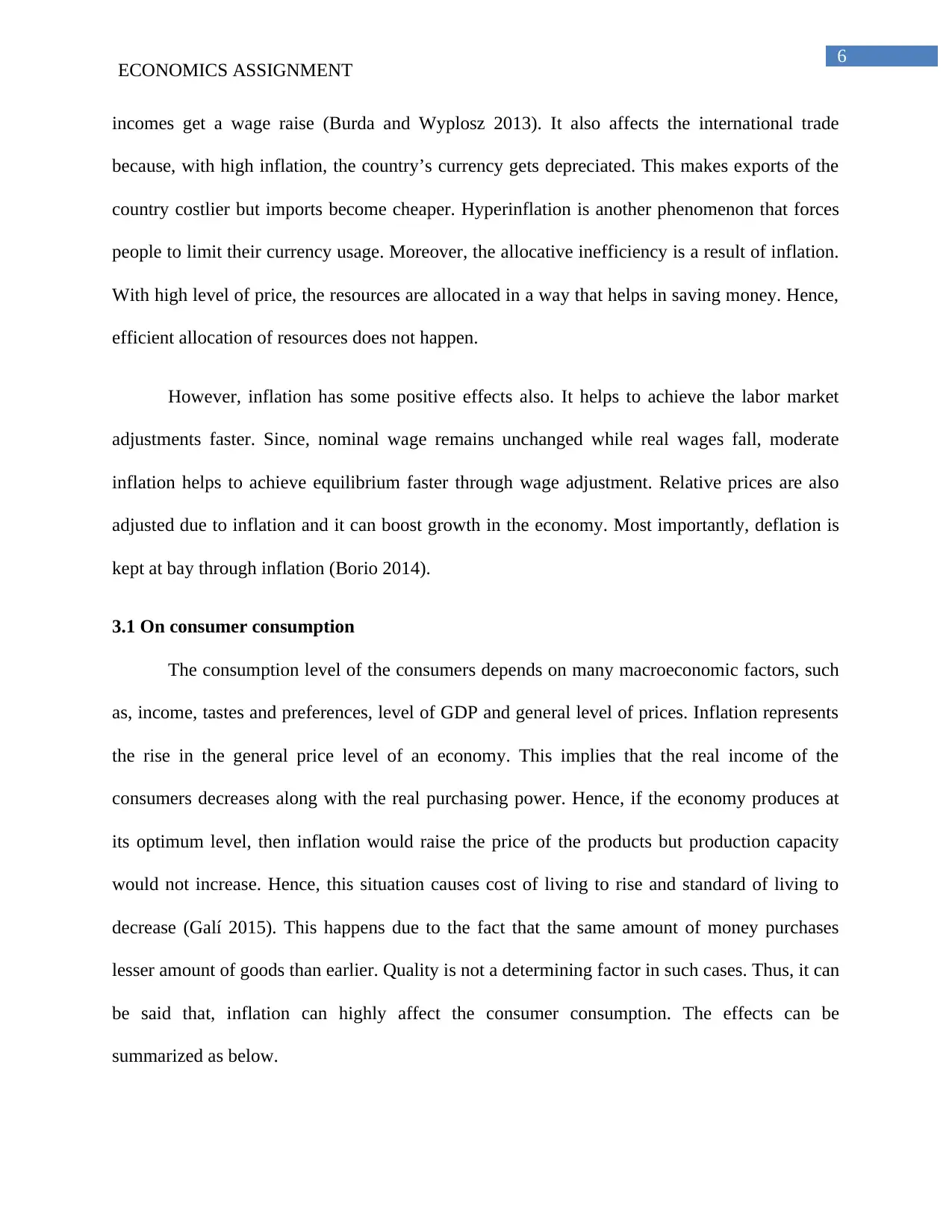
6
ECONOMICS ASSIGNMENT
incomes get a wage raise (Burda and Wyplosz 2013). It also affects the international trade
because, with high inflation, the country’s currency gets depreciated. This makes exports of the
country costlier but imports become cheaper. Hyperinflation is another phenomenon that forces
people to limit their currency usage. Moreover, the allocative inefficiency is a result of inflation.
With high level of price, the resources are allocated in a way that helps in saving money. Hence,
efficient allocation of resources does not happen.
However, inflation has some positive effects also. It helps to achieve the labor market
adjustments faster. Since, nominal wage remains unchanged while real wages fall, moderate
inflation helps to achieve equilibrium faster through wage adjustment. Relative prices are also
adjusted due to inflation and it can boost growth in the economy. Most importantly, deflation is
kept at bay through inflation (Borio 2014).
3.1 On consumer consumption
The consumption level of the consumers depends on many macroeconomic factors, such
as, income, tastes and preferences, level of GDP and general level of prices. Inflation represents
the rise in the general price level of an economy. This implies that the real income of the
consumers decreases along with the real purchasing power. Hence, if the economy produces at
its optimum level, then inflation would raise the price of the products but production capacity
would not increase. Hence, this situation causes cost of living to rise and standard of living to
decrease (Galí 2015). This happens due to the fact that the same amount of money purchases
lesser amount of goods than earlier. Quality is not a determining factor in such cases. Thus, it can
be said that, inflation can highly affect the consumer consumption. The effects can be
summarized as below.
ECONOMICS ASSIGNMENT
incomes get a wage raise (Burda and Wyplosz 2013). It also affects the international trade
because, with high inflation, the country’s currency gets depreciated. This makes exports of the
country costlier but imports become cheaper. Hyperinflation is another phenomenon that forces
people to limit their currency usage. Moreover, the allocative inefficiency is a result of inflation.
With high level of price, the resources are allocated in a way that helps in saving money. Hence,
efficient allocation of resources does not happen.
However, inflation has some positive effects also. It helps to achieve the labor market
adjustments faster. Since, nominal wage remains unchanged while real wages fall, moderate
inflation helps to achieve equilibrium faster through wage adjustment. Relative prices are also
adjusted due to inflation and it can boost growth in the economy. Most importantly, deflation is
kept at bay through inflation (Borio 2014).
3.1 On consumer consumption
The consumption level of the consumers depends on many macroeconomic factors, such
as, income, tastes and preferences, level of GDP and general level of prices. Inflation represents
the rise in the general price level of an economy. This implies that the real income of the
consumers decreases along with the real purchasing power. Hence, if the economy produces at
its optimum level, then inflation would raise the price of the products but production capacity
would not increase. Hence, this situation causes cost of living to rise and standard of living to
decrease (Galí 2015). This happens due to the fact that the same amount of money purchases
lesser amount of goods than earlier. Quality is not a determining factor in such cases. Thus, it can
be said that, inflation can highly affect the consumer consumption. The effects can be
summarized as below.
Paraphrase This Document
Need a fresh take? Get an instant paraphrase of this document with our AI Paraphraser
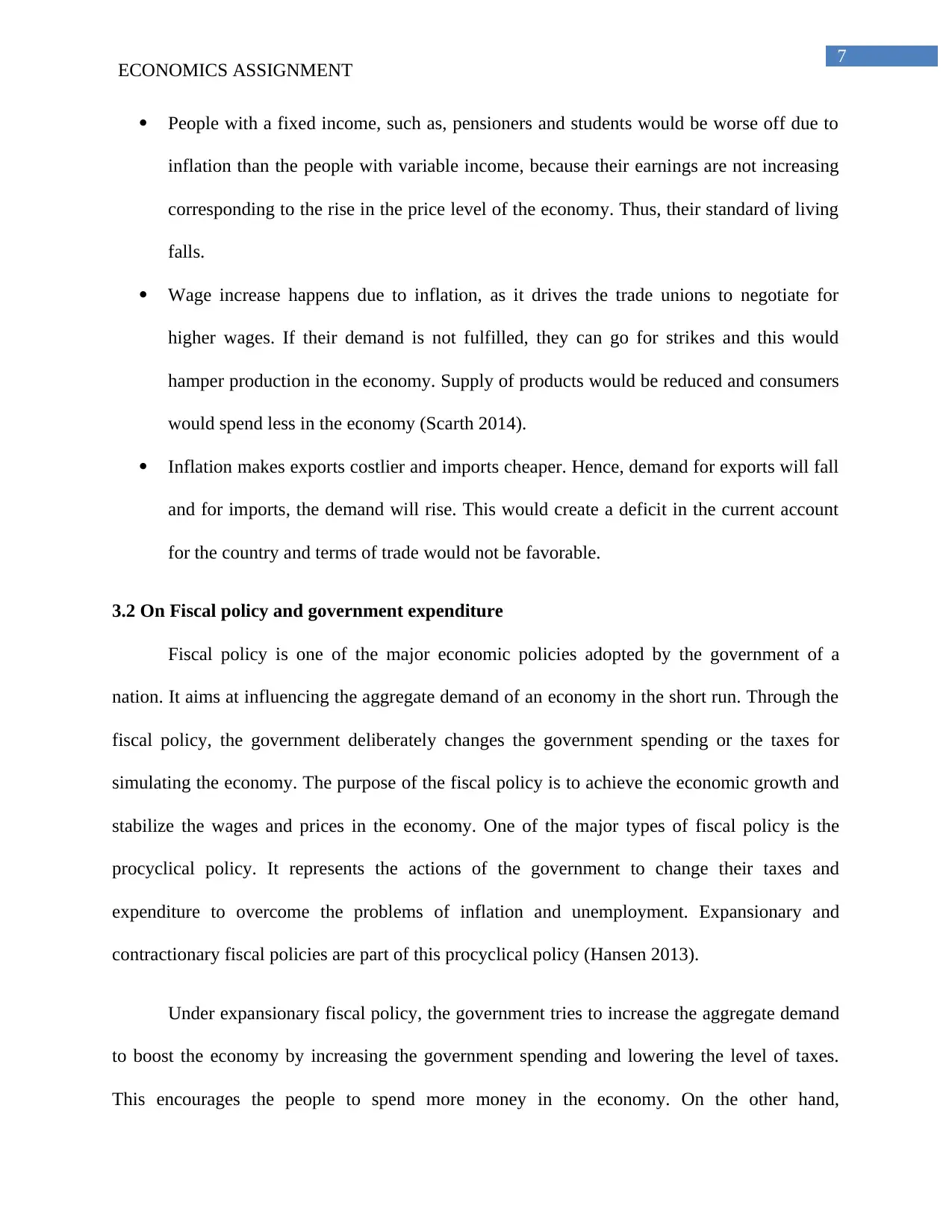
7
ECONOMICS ASSIGNMENT
People with a fixed income, such as, pensioners and students would be worse off due to
inflation than the people with variable income, because their earnings are not increasing
corresponding to the rise in the price level of the economy. Thus, their standard of living
falls.
Wage increase happens due to inflation, as it drives the trade unions to negotiate for
higher wages. If their demand is not fulfilled, they can go for strikes and this would
hamper production in the economy. Supply of products would be reduced and consumers
would spend less in the economy (Scarth 2014).
Inflation makes exports costlier and imports cheaper. Hence, demand for exports will fall
and for imports, the demand will rise. This would create a deficit in the current account
for the country and terms of trade would not be favorable.
3.2 On Fiscal policy and government expenditure
Fiscal policy is one of the major economic policies adopted by the government of a
nation. It aims at influencing the aggregate demand of an economy in the short run. Through the
fiscal policy, the government deliberately changes the government spending or the taxes for
simulating the economy. The purpose of the fiscal policy is to achieve the economic growth and
stabilize the wages and prices in the economy. One of the major types of fiscal policy is the
procyclical policy. It represents the actions of the government to change their taxes and
expenditure to overcome the problems of inflation and unemployment. Expansionary and
contractionary fiscal policies are part of this procyclical policy (Hansen 2013).
Under expansionary fiscal policy, the government tries to increase the aggregate demand
to boost the economy by increasing the government spending and lowering the level of taxes.
This encourages the people to spend more money in the economy. On the other hand,
ECONOMICS ASSIGNMENT
People with a fixed income, such as, pensioners and students would be worse off due to
inflation than the people with variable income, because their earnings are not increasing
corresponding to the rise in the price level of the economy. Thus, their standard of living
falls.
Wage increase happens due to inflation, as it drives the trade unions to negotiate for
higher wages. If their demand is not fulfilled, they can go for strikes and this would
hamper production in the economy. Supply of products would be reduced and consumers
would spend less in the economy (Scarth 2014).
Inflation makes exports costlier and imports cheaper. Hence, demand for exports will fall
and for imports, the demand will rise. This would create a deficit in the current account
for the country and terms of trade would not be favorable.
3.2 On Fiscal policy and government expenditure
Fiscal policy is one of the major economic policies adopted by the government of a
nation. It aims at influencing the aggregate demand of an economy in the short run. Through the
fiscal policy, the government deliberately changes the government spending or the taxes for
simulating the economy. The purpose of the fiscal policy is to achieve the economic growth and
stabilize the wages and prices in the economy. One of the major types of fiscal policy is the
procyclical policy. It represents the actions of the government to change their taxes and
expenditure to overcome the problems of inflation and unemployment. Expansionary and
contractionary fiscal policies are part of this procyclical policy (Hansen 2013).
Under expansionary fiscal policy, the government tries to increase the aggregate demand
to boost the economy by increasing the government spending and lowering the level of taxes.
This encourages the people to spend more money in the economy. On the other hand,
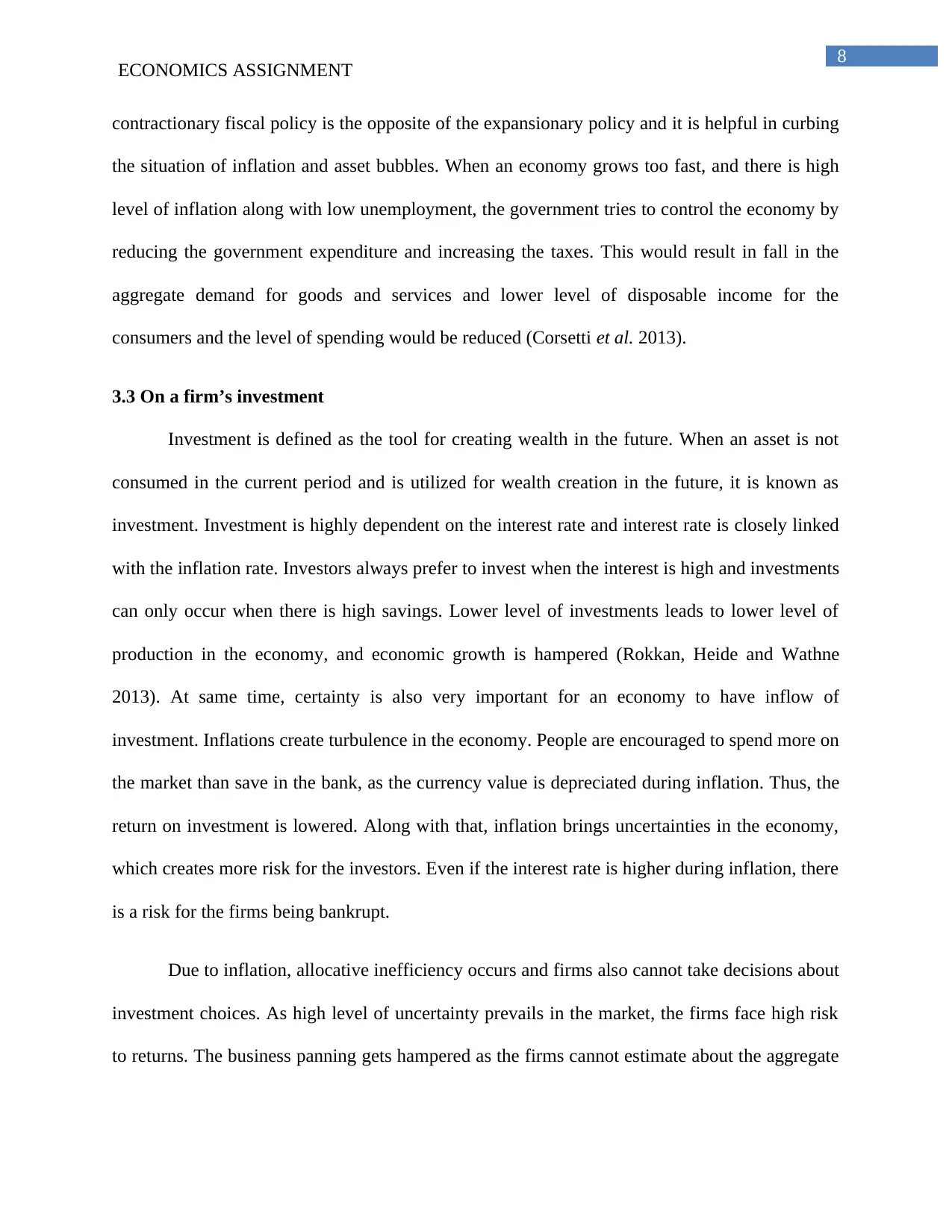
8
ECONOMICS ASSIGNMENT
contractionary fiscal policy is the opposite of the expansionary policy and it is helpful in curbing
the situation of inflation and asset bubbles. When an economy grows too fast, and there is high
level of inflation along with low unemployment, the government tries to control the economy by
reducing the government expenditure and increasing the taxes. This would result in fall in the
aggregate demand for goods and services and lower level of disposable income for the
consumers and the level of spending would be reduced (Corsetti et al. 2013).
3.3 On a firm’s investment
Investment is defined as the tool for creating wealth in the future. When an asset is not
consumed in the current period and is utilized for wealth creation in the future, it is known as
investment. Investment is highly dependent on the interest rate and interest rate is closely linked
with the inflation rate. Investors always prefer to invest when the interest is high and investments
can only occur when there is high savings. Lower level of investments leads to lower level of
production in the economy, and economic growth is hampered (Rokkan, Heide and Wathne
2013). At same time, certainty is also very important for an economy to have inflow of
investment. Inflations create turbulence in the economy. People are encouraged to spend more on
the market than save in the bank, as the currency value is depreciated during inflation. Thus, the
return on investment is lowered. Along with that, inflation brings uncertainties in the economy,
which creates more risk for the investors. Even if the interest rate is higher during inflation, there
is a risk for the firms being bankrupt.
Due to inflation, allocative inefficiency occurs and firms also cannot take decisions about
investment choices. As high level of uncertainty prevails in the market, the firms face high risk
to returns. The business panning gets hampered as the firms cannot estimate about the aggregate
ECONOMICS ASSIGNMENT
contractionary fiscal policy is the opposite of the expansionary policy and it is helpful in curbing
the situation of inflation and asset bubbles. When an economy grows too fast, and there is high
level of inflation along with low unemployment, the government tries to control the economy by
reducing the government expenditure and increasing the taxes. This would result in fall in the
aggregate demand for goods and services and lower level of disposable income for the
consumers and the level of spending would be reduced (Corsetti et al. 2013).
3.3 On a firm’s investment
Investment is defined as the tool for creating wealth in the future. When an asset is not
consumed in the current period and is utilized for wealth creation in the future, it is known as
investment. Investment is highly dependent on the interest rate and interest rate is closely linked
with the inflation rate. Investors always prefer to invest when the interest is high and investments
can only occur when there is high savings. Lower level of investments leads to lower level of
production in the economy, and economic growth is hampered (Rokkan, Heide and Wathne
2013). At same time, certainty is also very important for an economy to have inflow of
investment. Inflations create turbulence in the economy. People are encouraged to spend more on
the market than save in the bank, as the currency value is depreciated during inflation. Thus, the
return on investment is lowered. Along with that, inflation brings uncertainties in the economy,
which creates more risk for the investors. Even if the interest rate is higher during inflation, there
is a risk for the firms being bankrupt.
Due to inflation, allocative inefficiency occurs and firms also cannot take decisions about
investment choices. As high level of uncertainty prevails in the market, the firms face high risk
to returns. The business panning gets hampered as the firms cannot estimate about the aggregate
⊘ This is a preview!⊘
Do you want full access?
Subscribe today to unlock all pages.

Trusted by 1+ million students worldwide
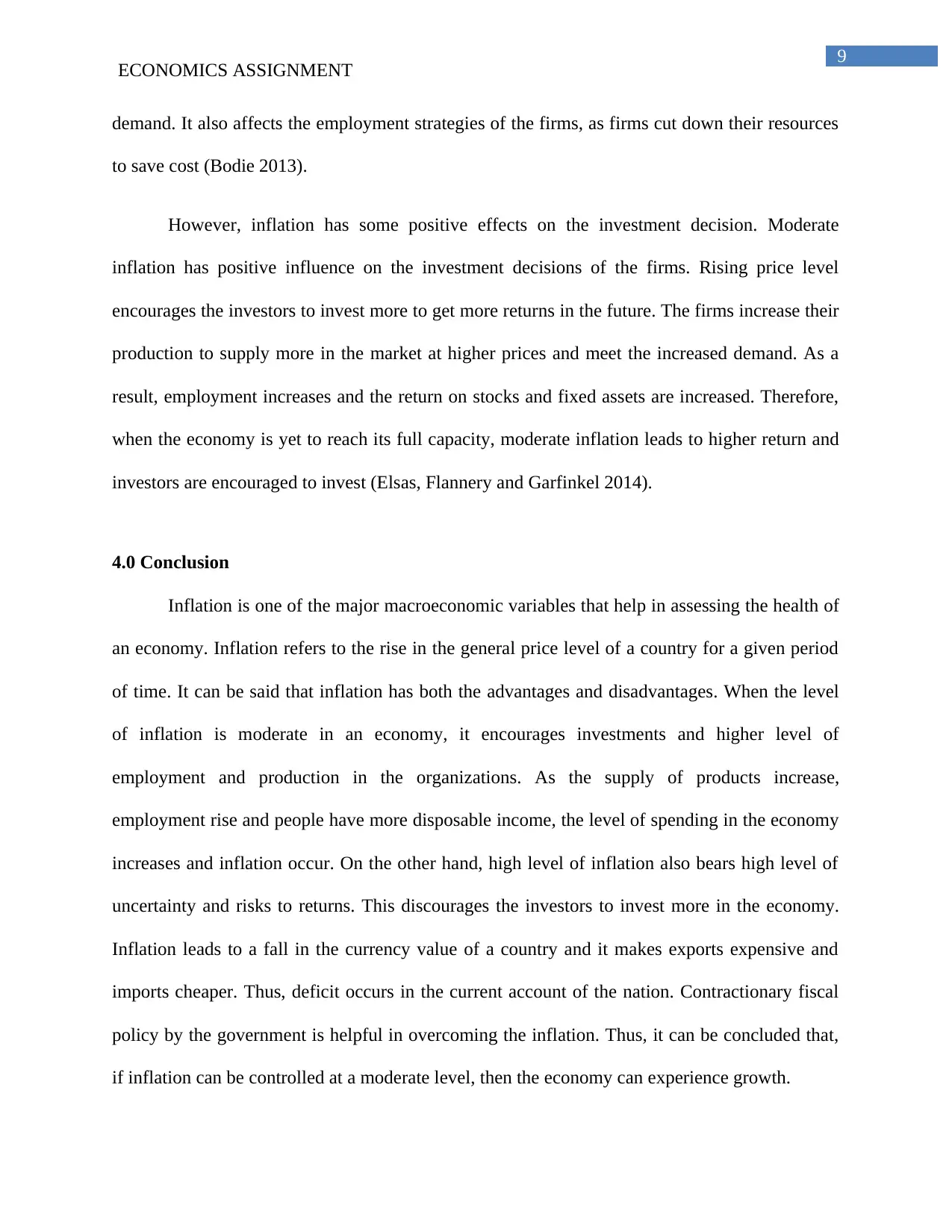
9
ECONOMICS ASSIGNMENT
demand. It also affects the employment strategies of the firms, as firms cut down their resources
to save cost (Bodie 2013).
However, inflation has some positive effects on the investment decision. Moderate
inflation has positive influence on the investment decisions of the firms. Rising price level
encourages the investors to invest more to get more returns in the future. The firms increase their
production to supply more in the market at higher prices and meet the increased demand. As a
result, employment increases and the return on stocks and fixed assets are increased. Therefore,
when the economy is yet to reach its full capacity, moderate inflation leads to higher return and
investors are encouraged to invest (Elsas, Flannery and Garfinkel 2014).
4.0 Conclusion
Inflation is one of the major macroeconomic variables that help in assessing the health of
an economy. Inflation refers to the rise in the general price level of a country for a given period
of time. It can be said that inflation has both the advantages and disadvantages. When the level
of inflation is moderate in an economy, it encourages investments and higher level of
employment and production in the organizations. As the supply of products increase,
employment rise and people have more disposable income, the level of spending in the economy
increases and inflation occur. On the other hand, high level of inflation also bears high level of
uncertainty and risks to returns. This discourages the investors to invest more in the economy.
Inflation leads to a fall in the currency value of a country and it makes exports expensive and
imports cheaper. Thus, deficit occurs in the current account of the nation. Contractionary fiscal
policy by the government is helpful in overcoming the inflation. Thus, it can be concluded that,
if inflation can be controlled at a moderate level, then the economy can experience growth.
ECONOMICS ASSIGNMENT
demand. It also affects the employment strategies of the firms, as firms cut down their resources
to save cost (Bodie 2013).
However, inflation has some positive effects on the investment decision. Moderate
inflation has positive influence on the investment decisions of the firms. Rising price level
encourages the investors to invest more to get more returns in the future. The firms increase their
production to supply more in the market at higher prices and meet the increased demand. As a
result, employment increases and the return on stocks and fixed assets are increased. Therefore,
when the economy is yet to reach its full capacity, moderate inflation leads to higher return and
investors are encouraged to invest (Elsas, Flannery and Garfinkel 2014).
4.0 Conclusion
Inflation is one of the major macroeconomic variables that help in assessing the health of
an economy. Inflation refers to the rise in the general price level of a country for a given period
of time. It can be said that inflation has both the advantages and disadvantages. When the level
of inflation is moderate in an economy, it encourages investments and higher level of
employment and production in the organizations. As the supply of products increase,
employment rise and people have more disposable income, the level of spending in the economy
increases and inflation occur. On the other hand, high level of inflation also bears high level of
uncertainty and risks to returns. This discourages the investors to invest more in the economy.
Inflation leads to a fall in the currency value of a country and it makes exports expensive and
imports cheaper. Thus, deficit occurs in the current account of the nation. Contractionary fiscal
policy by the government is helpful in overcoming the inflation. Thus, it can be concluded that,
if inflation can be controlled at a moderate level, then the economy can experience growth.
Paraphrase This Document
Need a fresh take? Get an instant paraphrase of this document with our AI Paraphraser
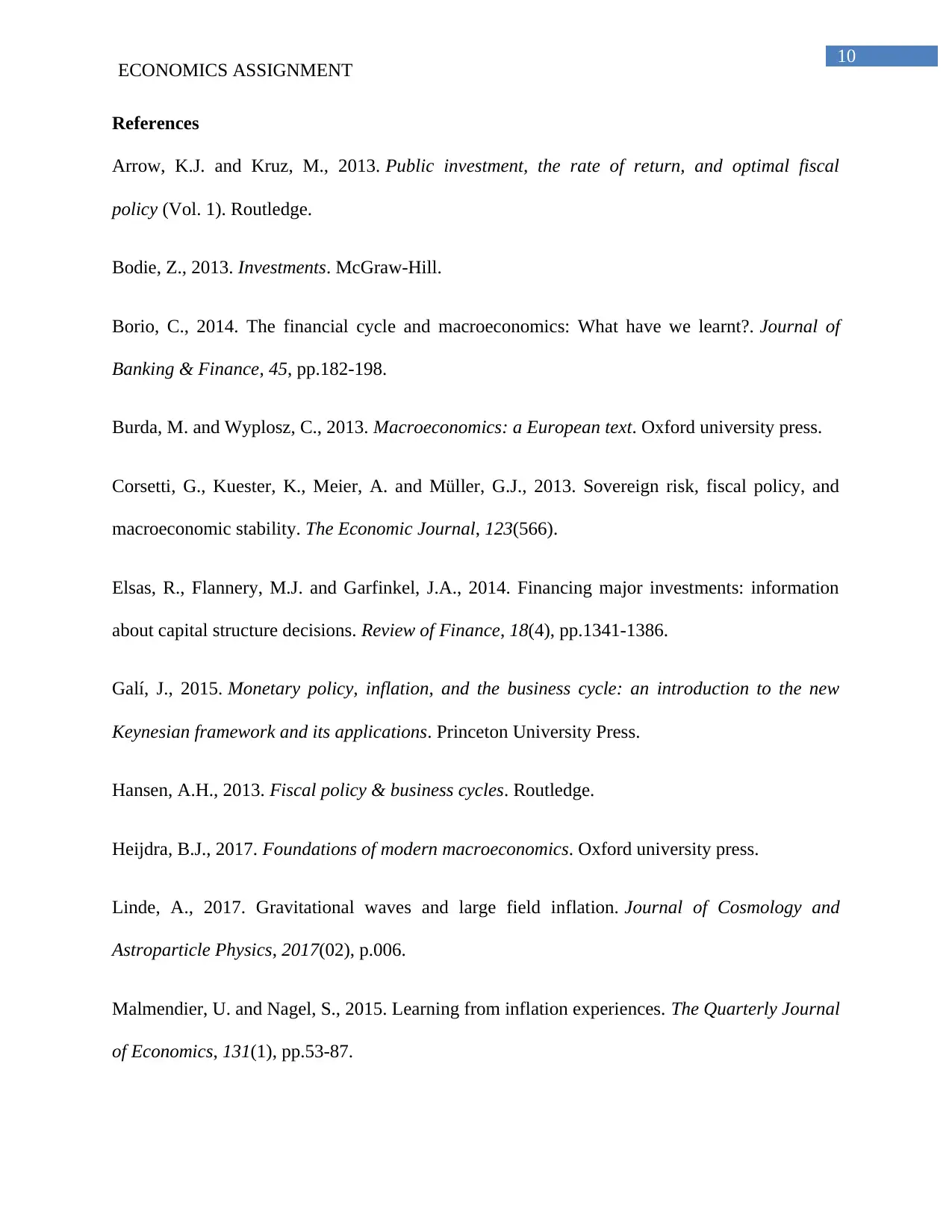
10
ECONOMICS ASSIGNMENT
References
Arrow, K.J. and Kruz, M., 2013. Public investment, the rate of return, and optimal fiscal
policy (Vol. 1). Routledge.
Bodie, Z., 2013. Investments. McGraw-Hill.
Borio, C., 2014. The financial cycle and macroeconomics: What have we learnt?. Journal of
Banking & Finance, 45, pp.182-198.
Burda, M. and Wyplosz, C., 2013. Macroeconomics: a European text. Oxford university press.
Corsetti, G., Kuester, K., Meier, A. and Müller, G.J., 2013. Sovereign risk, fiscal policy, and
macroeconomic stability. The Economic Journal, 123(566).
Elsas, R., Flannery, M.J. and Garfinkel, J.A., 2014. Financing major investments: information
about capital structure decisions. Review of Finance, 18(4), pp.1341-1386.
Galí, J., 2015. Monetary policy, inflation, and the business cycle: an introduction to the new
Keynesian framework and its applications. Princeton University Press.
Hansen, A.H., 2013. Fiscal policy & business cycles. Routledge.
Heijdra, B.J., 2017. Foundations of modern macroeconomics. Oxford university press.
Linde, A., 2017. Gravitational waves and large field inflation. Journal of Cosmology and
Astroparticle Physics, 2017(02), p.006.
Malmendier, U. and Nagel, S., 2015. Learning from inflation experiences. The Quarterly Journal
of Economics, 131(1), pp.53-87.
ECONOMICS ASSIGNMENT
References
Arrow, K.J. and Kruz, M., 2013. Public investment, the rate of return, and optimal fiscal
policy (Vol. 1). Routledge.
Bodie, Z., 2013. Investments. McGraw-Hill.
Borio, C., 2014. The financial cycle and macroeconomics: What have we learnt?. Journal of
Banking & Finance, 45, pp.182-198.
Burda, M. and Wyplosz, C., 2013. Macroeconomics: a European text. Oxford university press.
Corsetti, G., Kuester, K., Meier, A. and Müller, G.J., 2013. Sovereign risk, fiscal policy, and
macroeconomic stability. The Economic Journal, 123(566).
Elsas, R., Flannery, M.J. and Garfinkel, J.A., 2014. Financing major investments: information
about capital structure decisions. Review of Finance, 18(4), pp.1341-1386.
Galí, J., 2015. Monetary policy, inflation, and the business cycle: an introduction to the new
Keynesian framework and its applications. Princeton University Press.
Hansen, A.H., 2013. Fiscal policy & business cycles. Routledge.
Heijdra, B.J., 2017. Foundations of modern macroeconomics. Oxford university press.
Linde, A., 2017. Gravitational waves and large field inflation. Journal of Cosmology and
Astroparticle Physics, 2017(02), p.006.
Malmendier, U. and Nagel, S., 2015. Learning from inflation experiences. The Quarterly Journal
of Economics, 131(1), pp.53-87.
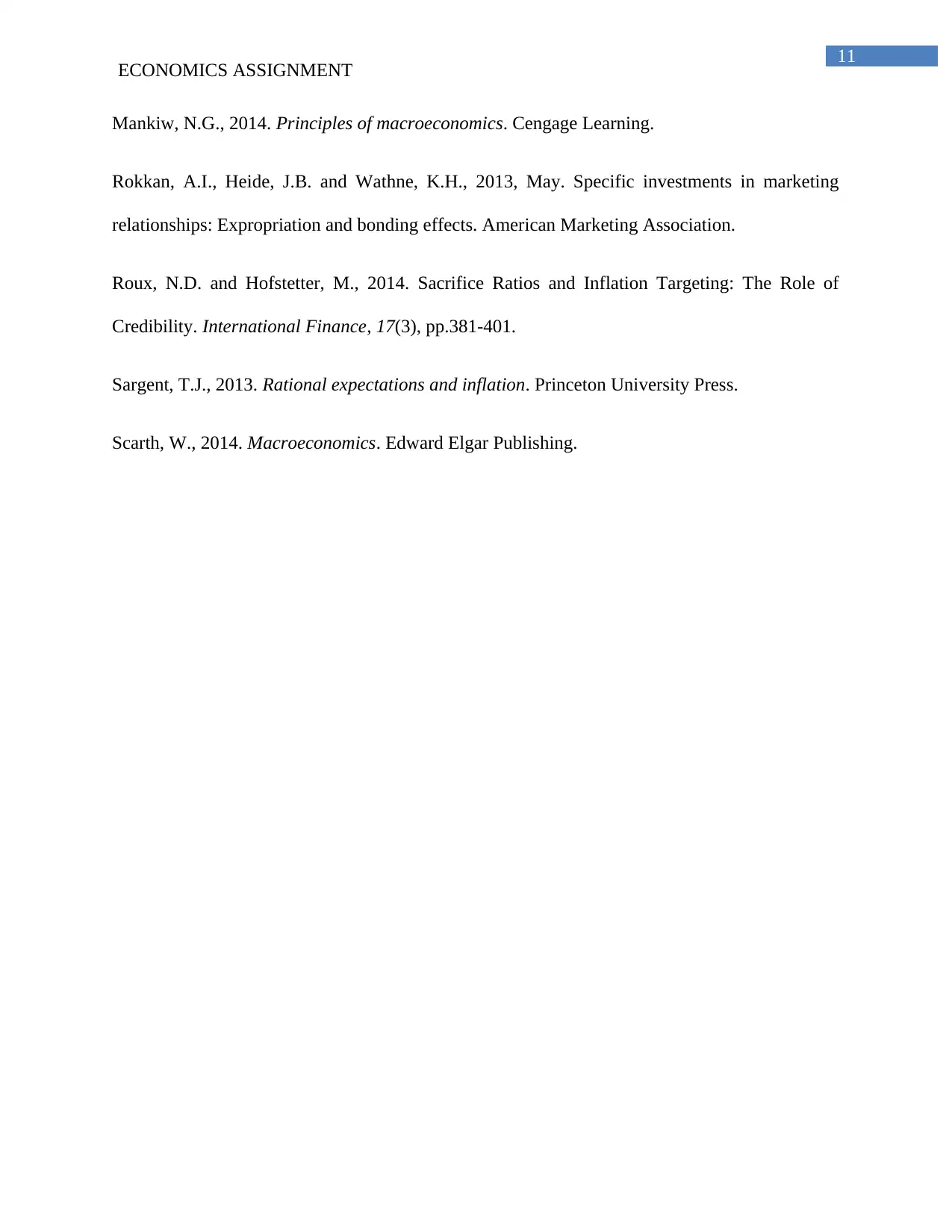
11
ECONOMICS ASSIGNMENT
Mankiw, N.G., 2014. Principles of macroeconomics. Cengage Learning.
Rokkan, A.I., Heide, J.B. and Wathne, K.H., 2013, May. Specific investments in marketing
relationships: Expropriation and bonding effects. American Marketing Association.
Roux, N.D. and Hofstetter, M., 2014. Sacrifice Ratios and Inflation Targeting: The Role of
Credibility. International Finance, 17(3), pp.381-401.
Sargent, T.J., 2013. Rational expectations and inflation. Princeton University Press.
Scarth, W., 2014. Macroeconomics. Edward Elgar Publishing.
ECONOMICS ASSIGNMENT
Mankiw, N.G., 2014. Principles of macroeconomics. Cengage Learning.
Rokkan, A.I., Heide, J.B. and Wathne, K.H., 2013, May. Specific investments in marketing
relationships: Expropriation and bonding effects. American Marketing Association.
Roux, N.D. and Hofstetter, M., 2014. Sacrifice Ratios and Inflation Targeting: The Role of
Credibility. International Finance, 17(3), pp.381-401.
Sargent, T.J., 2013. Rational expectations and inflation. Princeton University Press.
Scarth, W., 2014. Macroeconomics. Edward Elgar Publishing.
⊘ This is a preview!⊘
Do you want full access?
Subscribe today to unlock all pages.

Trusted by 1+ million students worldwide
1 out of 12
Related Documents
Your All-in-One AI-Powered Toolkit for Academic Success.
+13062052269
info@desklib.com
Available 24*7 on WhatsApp / Email
![[object Object]](/_next/static/media/star-bottom.7253800d.svg)
Unlock your academic potential
Copyright © 2020–2025 A2Z Services. All Rights Reserved. Developed and managed by ZUCOL.





